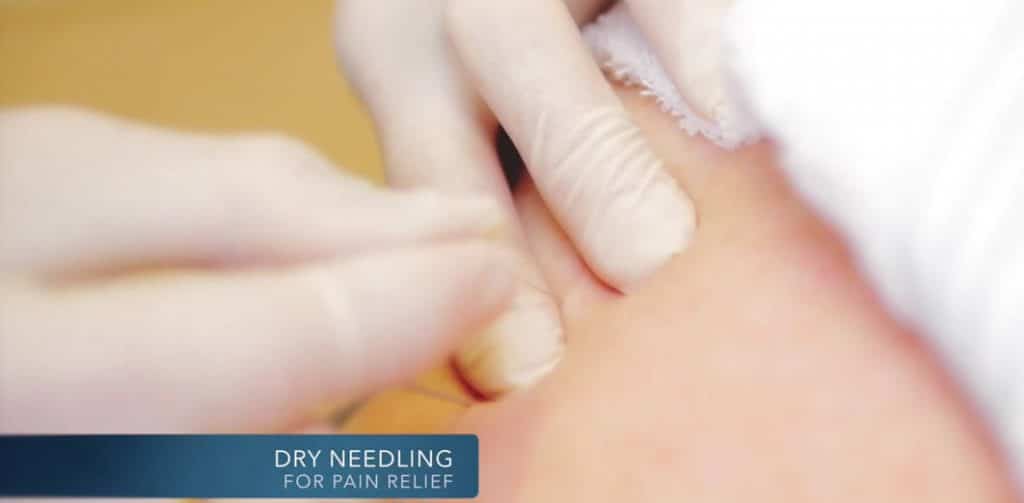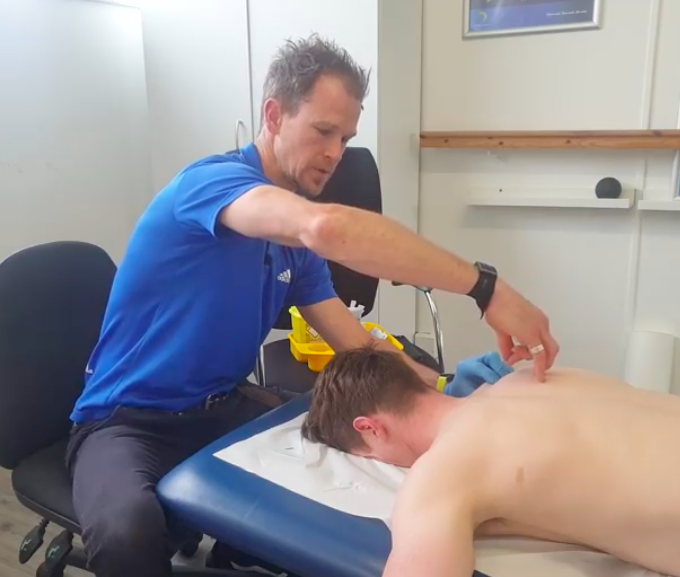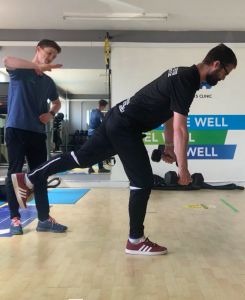Like to Speak to a Physio?
Click the button below to request a free call with one of our Physios.

Dry Needling uses a sterile filament needle that is inserted into the skin, fascia or muscle at particular points under the guidance of your physiotherapist.
It sounds far worse than it is and at our physiotherapy clinic in Cork we use it regularly as part of our treatments to help get our clients out of pain fast and for good, unlike being in the situation where you repeatedly have to turn to the pain medication to mask the pain for a few hours only to know that it is probably going to return.
You’ve come to the right place for a dry needling treatment. When you choose APC Physio and Sports Clinic, you enter a clinic with a clear helping culture. Whether you join us in Cork City or Fermoy, you’ll be met by our teams of chartered physiotherapists, whose only concerns are the relief of your pain, and the restoration of your strength and your normal active life.

Dry needling is a treatment of choice for trigger points. What exactly are trigger points? Also known as myofascial trigger points, they are probably best described as knots in muscles. They are quite easy to locate because when touched, they feel like hard, tight knots. They are a result of strain on the fascia that surrounds your muscles – either from too much repetitive movement, or from just the opposite – lack of movement. Stress can also be blamed for the occurrence of trigger points. And they do hurt!
The good news is that trigger points can be treated. Dry needling has proven to be a successful method for relieving the pain of trigger points, and many other types of muscular pain.
You may not have heard very much about dry needling. It is a relatively new therapy. All this discussion about trigger points and fascia may make it seem a little like something remote. However, it is those every day, garden variety pains that dry needling helps. Muscular pain is debilitating, limits your activities, and may cause discomfort in other areas of your body while you attempt to compensate for the pain.
It’s not really clear exactly how dry needling eases back and neck pain but research has shown that it does. Relief is often instantaneous. It is sustainable for periods of time, and can produce long-term results when combined with other therapies if necessary. At APC Physio, we understand the need for bespoke therapy. Every individual is different, and we are able to design a customised treatment plan according to your needs. One of our specialties focuses on back and sciatica pain. Another one zooms into problems of the neck and shoulders.
Although we offer a basket of physiotherapeutic approaches to relieve pain from migraines and headaches, we include dry needling as one of the methods that can bring quick relief from the pain. Repeated sessions, depending on the severity of the pain, can bring an end to your suffering from this very painful condition.
Many conditions are reflections of referred pain. The pain you feel in one area of the body may be the result of muscular tension elsewhere. Migraine headaches can be a result of trigger points in the neck. Conditions that are not necessarily painful, such as dizziness, may be a result of knots in the neck. A clicking jaw may be a result of repetitiveness (we do need to eat and talk!), which results in knots just below the ear lobe. Our dry needling Cork team is highly qualified to discern where the relevant trigger points are, and how to augment your treatment with additional physiotherapy treatments when appropriate.
Posture problems are also triggered by repetitiveness. In this case, it’s a lack of movement while the body is continuously bent in one position. (see Movement Revolution) An example would be an office worker sitting in his chair in front of a computer, hour after hour, day after day. Stroke patients also may be stressing muscles on the one hand, while suffering spasticity in other muscles. Dry needling can actually release the knots caused by poor posture, and reduce spasticity, allowing the client to regain some movement and muscle function. We also provide Pilates Classes which are fantastic for improving posture.
A thorough program for the treatment and prevention of sports injuries will include dry needling. By working on trigger points, dry needling removes stress from knotted muscles that result from most sports activities. This not only opens the way to a faster recovery for athletes who don’t appreciate sitting on the bench, but also helps to protect muscles by preventing injury. APC Physio prides itself in intensive experience helping athletes, and offers all-round treatments to supplement the dry needling. One example is our Movement Revolution class that works on all aspects of fitness and sports injury recovery, including range of motion, strength, and agility.
As many dry needling patients need treatment for sports and exercise injuries, they are concerned about which activities they can perform after a treatment.

Some modifications may need to be made, especially if the muscles that you are exercising are those that have been treated. For example, if you are a runner and your treated trigger points were positioned in your calf muscles, you may need to wait a day or two to return to your training. However, it may be a good idea to substitute your exercising with a workout that focuses on a different muscle group. In fact, discuss post-treatment ideas with your physiotherapist. They may actually recommend some light exercise after a treatment. It is also very important to drink lots of water during the 24 hours following your treatment.
There is often a two-way relationship between stress and pain. Any lifestyle “trigger points”, such as anxiety, emotional issues, job burnout, or financial problems, can produce those annoying knots of physical pain. Just as sufferers go for a swim or enjoy a massage in order to relax, dry needling can bring about both the physical and emotional relief you seek. It can start the process of unwinding for you, or complete a program aimed at relieving your stress. Throw in a gentle Pilates class to complete your return to a stress-free lifestyle.

When dry needling is practised, the needles are inserted into trigger points that have formed due to some kind of physical stress on the muscle.When acupuncture is practised, the needles are inserted into specific areas of the body in order to release a type of energy that will bring relief to an ailment.
Some patients report a pricking sensation. Others feel a contraction of a muscle. Yet others are not bothered by the sensation of the needles. Occasionally, the pain of the affected muscle may become more severe after treatment, yet movements may improve dramatically before the aching of the sore muscle begins to subside.
Three to eight treatments may be required. Typically, the number is closer to three. Other therapies are very likely to be part of your overall treatment plan to ensure the best results.
Typically, no more frequently than once every 5-7 days.
Dry needling has shown to be very effective in the relief of sciatica pain because the physiotherapist can follow the path of the nerve and the affected surrounding muscles and fascia that are contributing to the radiated pain.
Depending on the problem, a session can take between 10 minutes and half an hour. One half-hour is quite typical.
Click the button below to request a free call with one of our Physios.
By continuing to use this website, you consent to the use of cookies in accordance with our Cookie Policy.
Accept